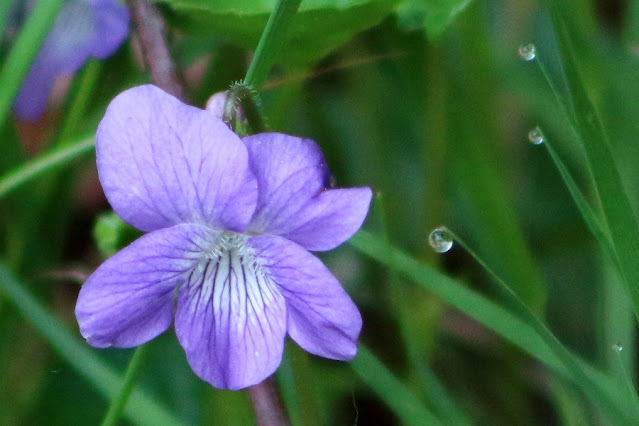I'm publishing early this week in case anyone wants to go out this weekend to look for woodland wildflowers. Most of the deep-woods flowers are blooming now, and by next weekend they may be going by, depending on the weather. One exception is the Lady's Slipper which usually doesn't bloom until late May, but you might get lucky and see an early bloomer this weekend. Last week I noted I found a couple of trilliums blooming, but this week there were many to be found.
 |
| Painted Trillium |
Several of the tiny white woodland flowers are also blooming, including the starflower and the goldthread.
 |
| Starflower |
There are still a few trailing arbutus around, but these, the earliest of the wildflowers, are mostly gone. All of these deep-wood flowers take advantage of a narrow window of opportunity after the ground warms up, but before all the trees leaf out. The bare branches of deciduous trees allow sufficient sun to reach the forest floor for these plants to collect enough energy to grow and flower before they are relegated to the dark shade of the forest. They will continue to photosynthesize throughout the summer with what little light does reach them, but that short window is what really keeps them going.
If your travels take you by more open sunny areas you're likely to see several other pretty blooms growing down at your feet. Two violets, the sweet white and the common blue are in bloom now.
 |
| I love the perfect spheres of dew on the blades of grass, |
Also down at ground level, wild strawberry are flowering, hoping to attract an early pollinator to let them set fruit for the birds later in the summer.
 |
| A future strawberry in the making. |
Another fruit-bearer is blooming as well, and judging by the quantity of blossoms, it appears another good blueberry season might be in store for us.
 |
| Lots of blossoms have been set on the blueberry bushes. |
Of course, this depends on sufficient rain coming during June and July, something we haven't seen in two weeks now.
Bridging the borders between sun and shade is one of my favorite flowers, the fringed polygala, which can spread into large patches.
 |
| Fringed Polygala |
I think it's the unusual color, somewhere between magenta and violet, that I find intriguing. You might also see bluets and lily-of-the-valley blooming right now.
 |
| Lily-of-the-valley |
The last flower I'll mention is a new one for me, and I had to work to determine what it is. Though I found it on the forest floor, it's not one that blooms down low, but rather up high in the forest canopy.
I expected it was a flower from a tree, but which tree? I found many of these flowers under hemlocks, but I knew that wasn't its host. Eventually, by looking up flowers of the various trees that grow in our forests, I determined it's the flower of the American Beech; it perfectly fits the description of the male beech flower in the Audubon guide "Eastern Forests". [Alfred A. Knopf, Inc, publisher, 1985] The flowers are very light, and with the strong winds this week, they could have blown a long way.
 |
| The tiny flower of the mighty beech tree. |
 |
| Chestnut-sided warbler. |
These birds tell me that we're nearing the end of the migration, as these birds, based on my observations, are among the last to arrive. I heard the oriole on the Wetland Loop Trail at Page Pond, high up in a tree with no chance to see it. Chestnut-sided warblers flit around in the thickets of young successional forests, but its song is so loud you can easily track it, and if you watch long enough you can usually get a glimpse of him (it's always him that sings). You're likely to see one along the Page Pond Field Trail at the Barnard Ridge Road trailhead. Listen for its distinctive "Pleased, pleased, pleased to MEET you" song.



No comments:
Post a Comment